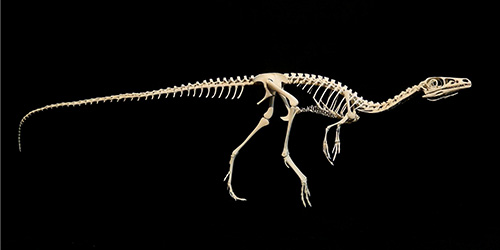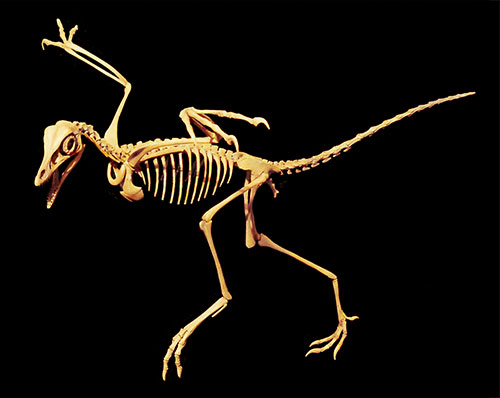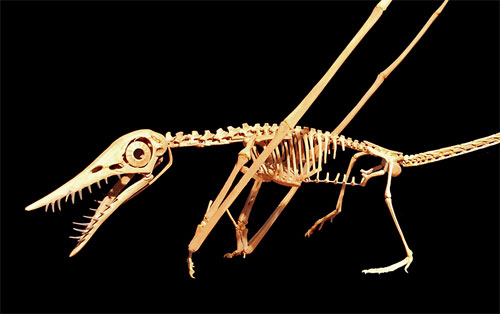Bruce is a modelmaker after my own heart—attention to detail and scientific accuracy are paramount. His skeletons are bone-by-bone reconstructions and include oft-neglected details such as gastralia, palate bones, sclerotic rings and even the hyoid apparatus, something I'd never seen reconstructed before!
It's important to note that Bruce's models are professional projects commissioned by and for large institutions. They're also full scale. Happily the subjects are not only important, they're small enough to put on home display. They represent seriously good science in a form accessible to discerning collectors. If you'd like to own a Bruce Mohn original you can find his contact information here.
Compsognathus longipes
Bruce's first skeleton model, Compsognathus longipes was done in 1996. The original sculpt was based on an excellent cast of the type specimen. It was sculpted full size in Super Sculpey over a steel armature, a process taking about three months. It was exhibited at the Society of Vertebrate Paleontology meeting in NYC that year, where it was well received.The original solid skeleton was cut apart to make masters for reproduction, taking an additional three months. Some 200 pieces went into each skeleton, allowing the skeleton to be mounted in any position the animal could assume in life.
Fifteen casts were sold to museums and universities around the world with minor changes being made over the years to reflect new discoveries. The skeleton was remastered in 2004, adding a third finger, gastralia, palate bones, hyoids, additional caudal vertebrae and generally refining the masters over a period of three months. Four casts were sold of the remastered skeleton. The current version is about four feet long and fifteen inches high.
Archaeopteryx lithographica
This was Bruce's second skeleton, done in 1998. It is based on a study of an excellent cast of the Berlin specimen. It was sculpted full size with a fifteen inch wingspan, a process taking about three months.
This is a mostly bone for bone reproduction, though the tail was sculpted and cast in one piece. This allows the skeleton to be mounted in any position the real animal could assume in life. Though the tail is cast rigid, its position can be easily modified by drilling out the first seven caudals and then cutting at the zygapophoses.
Seven casts were sold and are in museums and universities around the world. As originally mastered, the skull is lacking post orbital bones, which was prevailing wisdom at the time. Later versions were retrofitted with post-orbitals.
Pterodactylus antiquus
His third skeleton, Pterodactylus antiquus was sculpted over a year from 2006 to 2007. It is a more speculative work than his previous sculptures, being an adult-sized version of the well known Pterodactylus antiquus.
Although no complete specimen of P. antiquus is known in that size, isolated elements suggest that P. antiquus adults were in this size range or larger. The skull's crest is based on that seen in Gnathosaurus, which some workers have suggested is the adult form of P. antiquus.
Christopher Bennett served as an advisor for the project. Paul Pursglove was also of great assistance. Numerous references were gathered, including an excellent cast of P. kochi.
As with Bruce’s earlier works, the skeleton was produced more or less bone-for-bone, allowing it to be mounted in any position that the real animal could assume. To date, three casts have been sold to museums.
The Pterodactylus skeleton has a 104 cm wingspan. Skull is 19.5 cm. Body from atlas to terminal caudal is 34 cm (with curved neck).
Rhamphorhynchus muensteri
His most recent skeleton, Rhamphorhynchus muensteri was sculpted over a year from 2008 to 2009. It has a forty one inch wingspan and is based on Carnegie Museum of Natural History specimen number 11427, which is labeled as R. gemmingi, but has now been synonymized with R. muensteri. Photos of an acid prepped skeleton were provided by Sankar Chatterjee, Texas Tech University Museum. These and numerous references were used to produce the bone-for-bone masters.
Sculpting the extended processes on the tail was particularly trying. This piece is cast solid, but like the Archaeopteryx model, the tail can be repositioned without too much difficulty. Three casts have so far been produced.
With a 41 inch wingspan, it’s is based the Carnegie Museum specimen with Wellnhofer references used to fill in the gaps.



